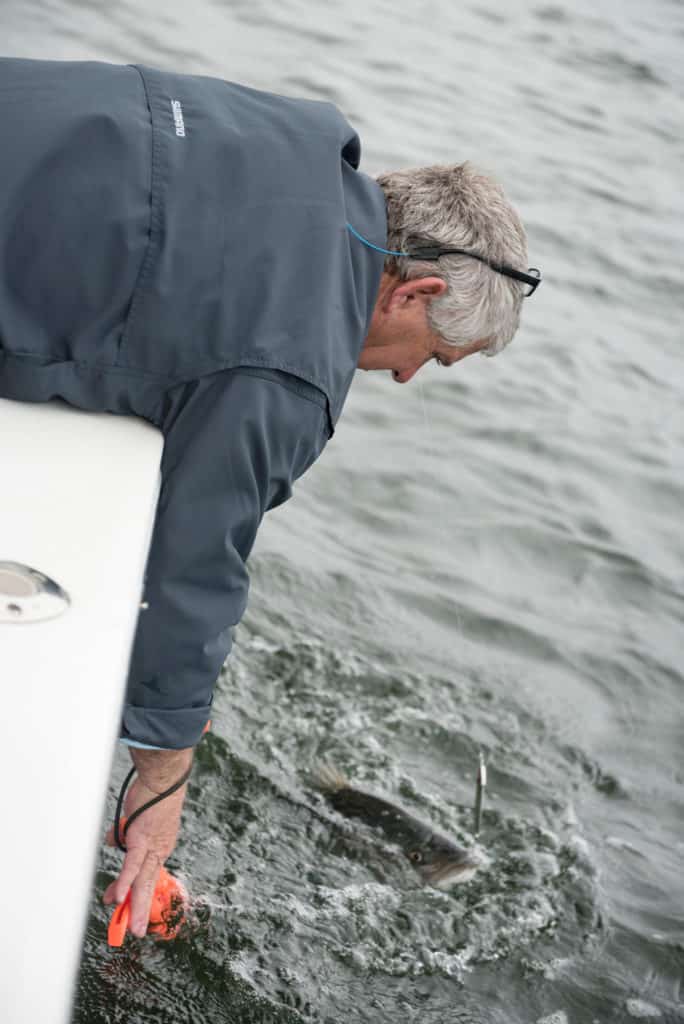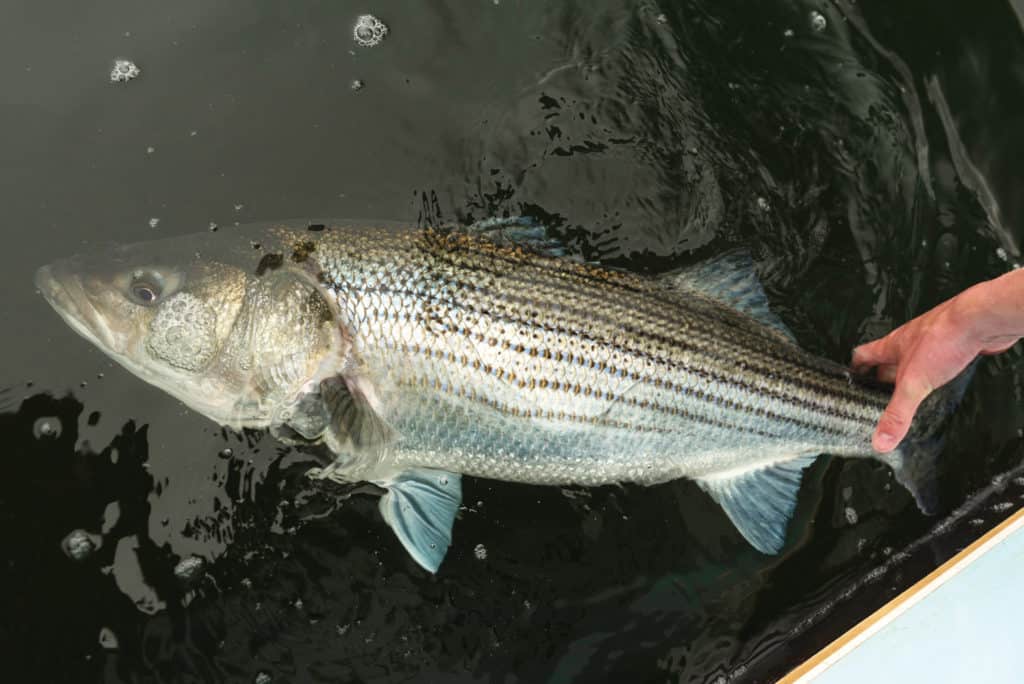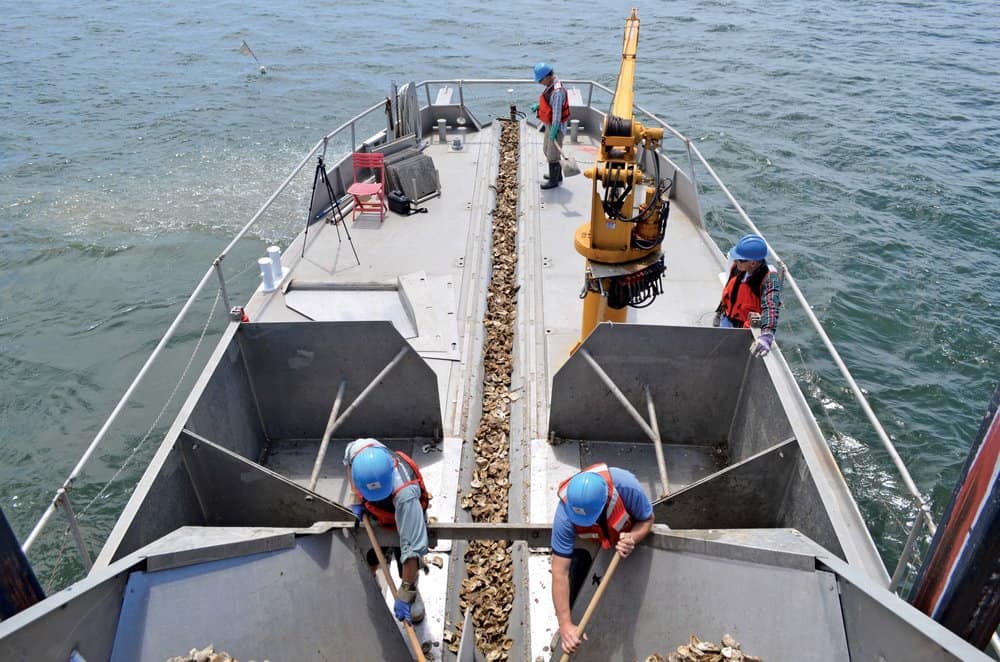Become part of the solution by practicing and planning solid catch and release technique.
If the primary purpose of fishing is to catch fish, why would we want or need to turn them loose? Well now, with fish resources pressured by many forces, there are lots of reasons for letting them go. They might be too small or too large to suit the legal limits, or out of season, or above the proscribed daily harvest limit. Maybe we are fishing solely for sport and not for the table? In any case, the act of catching and releasing a fish deserves concern and careful consideration for the well-being of the fish and the resource. We all want these fish to survive and thrive.
The recently confirmed troubled state of the striped bass population has forced us to confront the reality that recreational catch and release activity is the largest cause of Atlantic striped bass mortality. To be sure, commercial and recreational harvest mortality is substantial and needs some moderation to help us get back on track. But, with a steady increase in recreational fishing in the Bay and the last year’s harvest limits of two 18-inch or longer fish per day per angler (probably headed to one fish for 2020), very many undersized and over-the-limit fish are being caught and released. Fisheries biologists have determined that an average of nine percent of them don’t survive. The mathematical result of so many people fishing and releasing fish and the nine-percent mortality is shocking. Consequently, we face tighter restrictions on harvest and targeted catch-and-release. No, we’re not headed for a striped bass moratorium like the one we endured in the late 1980s. Our science is much better now, and the stock is not in crisis, but warning lights are flashing. It’s time to pay serious attention. And not just to rockfish.
Fish in and out of water
Consider the struggle. No matter how tough the battle may have been on the angler, you can be sure it was much worse for the fish. The combination of the reel’s drag, the resistance generated by the line moving through the water, and the shock-absorbing design of the rod are intended to tame or exhaust the fish. The fish soon uses up its oxygen and its muscles shift to anaerobic respiration, which causes substantial distress from the buildup of lactic acid. The fish tires and needs to recover, just as the angler would if the situation was reversed. But most often, the fish will be lifted from the water to be admired, photographed, and “thrown back”—a common but unfortunate word choice.
Water density is nearly 800 times that of air. Expressed another way, air at sea level has about 0.1275% of the density of water, a huge difference. Think about how water supports you when you swim and float. A fish is built to suspend in water. Out of its element, a fish’s gill filaments, which suspend in the water to present as much surface area as possible to absorb dissolved oxygen, collapse and the fish loses much of its oxygen absorbing capacity just when it needs it most. Also, the uniform support of being submerged is important for the function and safety of a fish’s internal organs and structure. Out of the water, the vanquished gamefish may be entirely supported by a hook in its lip or by the angler’s grip in it lower jaw. What is happening to that fish’s bone structures? If it’s hanging from a lipping device, is the pull of gravity separating its vertebrae? Are the internal organs sagging or being compressed by the weight of the body above them? What happens if the fish is accidentally dropped onto the deck? Or, in the care of an informed and careful angler, the fish may be supported, even cradled, in his forearm or in a soft-rubber net before being revived and released. Of course, the longer a fish is out of the water, the more it is stressed.
Another major issue is the difference in temperature between the water and the air. Summertime Bay water can easily reach 85 degrees or more, rockfish are already uncomfortable, and warmer air adds even more stress. Biologists estimate that 90-degree air temperature can result in a 50-percent mortality rate, even if the fish is handled gently and quickly.
What about hook wounds? Research has shown that a simple hole in the membrane inside the lower lip of striped bass and other similar fish heals quickly, but some fish, such as sea trout and gray trout have mouths that are more fragile. Hook wounds can be minor, but they can also be major causes of release mortality, especially if the fish swallows whatever lure or bait it has struck, so that part of the hook ends up inside its intestines.
Handling can rub off the protective coating on the fish’s skin, which acts as a barrier for pathogens. Rough, knotted nets, dry human hands, and non-skid decks are especially effective at removing the fish’s slime. The effect may not be immediate, and the fish may appear to swim away strongly, but a break in its slime coating may allow a lethal bacterial attack.
Okay, this is pretty dismal stuff, but understanding the risk factors makes it easier to see how catch-and-release mortality can be so high, especially in the summertime. The good news is, there are scientifically documented ways to reduce the stresses. Let’s take them one at a time.
Selective Harvest
Selective Harvest describes a plan for deciding in advance what species you will target and what you will do when you catch them. Will you keep some of them or let them all go? How many will you keep? Do you have everything you need to preserve the fish you keep and the tools and a routine for carefully releasing undersized fish? How will you orchestrate the photography and release? Sounds like common sense, doesn’t it?
Minimizing Hook Wounds

If you’re fishing with natural bait, use non-offset circle hooks, which almost always catch fish in the corner of the jaw instead of deeper in the internal organs or gills. In Maryland, circle hooks are required for fishing with natural bait. Virginia encourages the practice through the state’s Fish F.A.S.T for Striped Bass Program—Focus on a quick release; Always use approproate tackle; Swim the fish to re-oxygenerate it; Try to remove the hook while the fish is in the water (mrc.virginia.gov/Notices/circle-hooks). Crimp down the barbs to make the release process less damaging and easier.
Opt for lures with single hooks, an easy choice when fishing with flies, jigs, spoons, and soft plastic lures because that’s how they come. Poppers, spooks, crankbaits, and suspending jerkbaits often come with treble hooks. Clip one tine off each treble and crimp the remaining barbs. The resulting double hooks still catch effectively, and they are much easier to remove from the fish, especially with a pair of pliers or a de-hooker tool. They also minimize the chances of hooking the fish in two places. If the removal of tines upsets the lure’s balance, replace the existing trebles with larger hooks and still remove the tines to keep the total hook weight the same as with the stock trebles. Or, even better, replace the treble hooks with large single hooks.
Fight Stress
Use tackle that is up to the task to minimize the fight time. Let your rod and your reel’s drag work for you to absorb shock and pressure the fish into succumbing. Shortening the fight time will reduce stress on the fish.
At Hand
When the fish comes to hand, you’ll need to control it. The best course for a fish you will release is to slip the barbless hook out of its mouth right there in the water, without lifting the fish out of the water, and let it swim away. You can very well take a photo of a memorable catch while it is in the water, even with a measuring device held alongside to indicate its length.
If you must lift it out of the water, be sure to support it by its body and allow it to lie flat without scraping off protective slime. The best tool for this job is a flat-bottom net with rubber or coated, knotless netting such as the cradle nets used by Midwestern musky and West Coast steelhead anglers. If using just your hands, support the head with one and the body under the anal fin with the other. If you must lay the fish down to measure it, lay it on a wet towel. Anything you can do to keep the fish calm helps, like turning it upside down or covering its eyes with a wet towel.
Time Out of the Water
Planning ahead is the key to minimizing the fish’s time out of the water. If you are going to photograph your fish, make a plan in advance including positioning for good lighting and camera angle. Keep the camera ready. A good rule of thumb is to keep the fish out of the water no longer than you can hold your breath—about 30 seconds.
De-Hooker Tools
Young rockfish and white perch are like hyperactive pin cushions. Handling them is not good for their health or your hands. Learn to release them with a de-hooker, a process that takes no more than a couple of seconds. Basically, this button-hook tool inverts the hook so that the fish drops off, into the water with a gentle shake. It works much better if the hook’s barb is crimped and the fish is close to the water when it comes off. You’ll be amazed at how much time this tool saves, as well as the benefits for the fish and your hands. It’s easy to make your own de-hooker with stiff, heavy-gauge wire or welding rod, but many tackle shops sell them ready-made for just a few dollars. Hemostats and longnose pliers also do a good job of removing a hook.
Avoid Stressful Seasons
Avoid fishing at times when warm water conditions are stressful for fish, especially striped bass., which prefer cold, salty water. The prime example is the dog days of summer, July and August. This is a good time to consider other, smaller game fish such as white perch and catfish, which tolerate the heat better. Or hunt snakeheads, which thrive in tepid, shallow waters, and they are challenging to catch and delicious
to eat.
In the lower Bay, go for sheepshead, spadefish, red drum or cobia. The Chesapeake’s many fish species peak at different times of the year.
Fishing the seasons will teach you a lot, make you smile, and feed you well.




